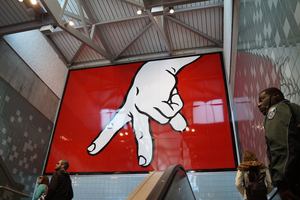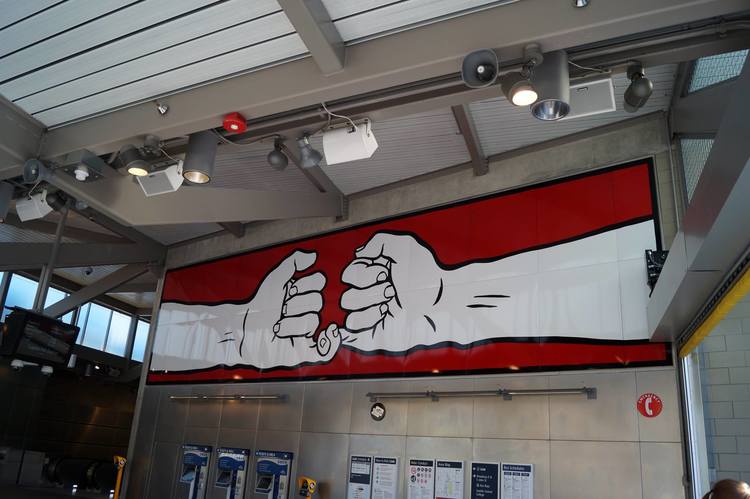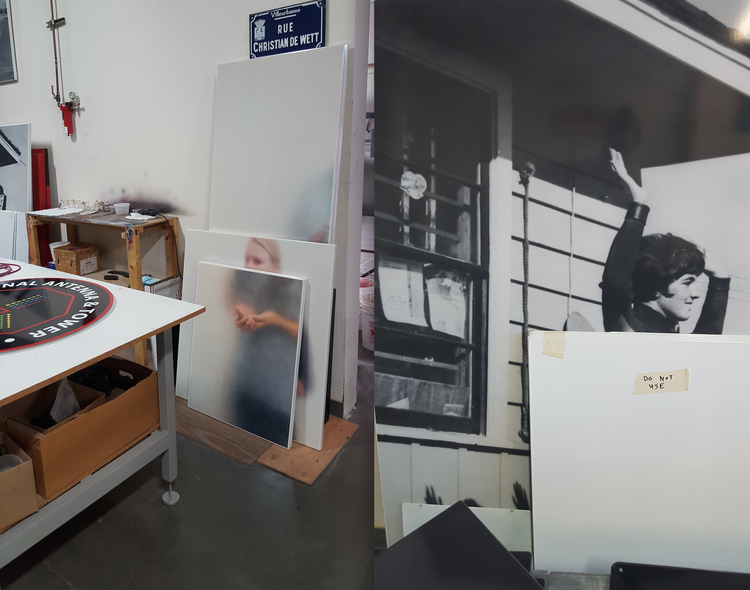This is the sixth in a series of guest posts by the enamel artist Kat Cole. This post previously appeared on her blog.
Note: It is at this point I would like to say thank you to the people that were integral to making my trip possible, those that were so generous to open up their homes to me and share their knowledge. Judy, Brooke, Linda, Steve–you all were my cheerleaders through what was both an incredibly stressful and exciting experience and I cannot thank you enough.

Installation by Ellen Forney in Seattle bus station, made by KVO Industries
KVO Industries is located in picturesque northern California in the small town of Santa Rosa. This operation has been fabricating porcelain enamel signage for the last 16 years and grew out of a larger factory that re-located away from Santa Rosa in 2000. KVO is a small company running impressive facilities with incredible possibilities. They have made signage for the state and national park systems, large-scale outdoor images for cities and museums, and worked with artists to re-create images of their work in enamel for public projects.
 On the Monday I arrived at KVO, I had planned to hit the ground running, having shipped off my crate 10 days earlier. It was to have arrived the Thursday before–but did not. I had been in contact with the freight company, and been assured several times it would get there on that Monday. So while I waited for my work to arrive I got to know my new studio for the week.
On the Monday I arrived at KVO, I had planned to hit the ground running, having shipped off my crate 10 days earlier. It was to have arrived the Thursday before–but did not. I had been in contact with the freight company, and been assured several times it would get there on that Monday. So while I waited for my work to arrive I got to know my new studio for the week.
 There is a front office housing operations and graphic design, among other things they deal with the challenge of color matching, translating what is shown on a screen into enamel color range. The warehouse holds the packing and shipping area, raw materials (mostly steel of various shapes), and a small fabrication area for welding on tabs or doing a little grinding.
There is a front office housing operations and graphic design, among other things they deal with the challenge of color matching, translating what is shown on a screen into enamel color range. The warehouse holds the packing and shipping area, raw materials (mostly steel of various shapes), and a small fabrication area for welding on tabs or doing a little grinding.
Then the layout room is filled with large tables for silk screening, an area for spraying down screens, and more big worktables. This is where I set up to work for the week. Next to the layout room is the main enameling area. There are rolling carts for hanging recently sprayed panels, a large spray booth, and the kiln. At the back of this room is the dry box that you roll carts into to quickly dry your enamels, the parts washer, and the mixing area.
 The first thing one might notice about all of these spaces is there are panels everywhere. They decorate the walls and line the edges of the rooms. Some are waiting for the next phase of a project, but most are rejects put aside because of a small chip or a miss-matched color. You see the variety of the work they have done everywhere.
The first thing one might notice about all of these spaces is there are panels everywhere. They decorate the walls and line the edges of the rooms. Some are waiting for the next phase of a project, but most are rejects put aside because of a small chip or a miss-matched color. You see the variety of the work they have done everywhere.
As an artist, I am not a perfectionist, and while I could eventually spot the flaws in these cast-offs, the level of perfection that they expect and achieve in their work was mind-boggling to me. For those of us that have enameled before, we know how hard it is to have consistent repeated perfection in this material. And during my time at KVO it was heartening to see that they occasionally struggle with some of the same technical issues I grapple with in my work. The difference is that they work to eliminate inconsistencies, while I embrace them.

Recent Comments